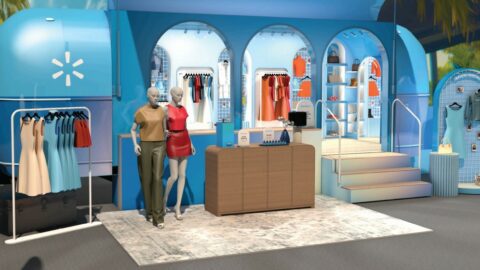During his 20 years in retail, Chris Walton has grown adept at combining a long-term, high-level view with a sharp focus on everyday practical business realities. As Vice President of Merchandising for Home Furnishings at Target.com, he oversaw Target’s first integrated store and digital merchandising and product development teams. Then he led Target’s Store of the Future initiative, eventually managing a team of 30+ people and a multi-million-dollar budget.
Now Walton shares the insights he’s gleaned as CEO of the Third Haus retail tech lab and the Omni Talk blog, and he will be speaking at Retail TouchPoints Live! @RetailX in Chicago, June 25-26.
Retail TouchPoints (RTP): What are some of the most significant innovations you see in retail today?
Chris Walton: There are four technologies that fascinate me: search; social commerce; scan-and-go and checkout-free shopping; and micro-warehousing.
In terms of search, what blows my mind is the following statistic: 85% of the time when consumers know what they want, they search on Amazon or Google — which means that they are only going to retailers’ web sites 15% of the time, and that number has been on the decline. Right now, search is about helping us do what we explicitly tell a system to do, but there is so much context in and around how we can search or even discover products — both online and in the physical world — that is yet untapped. Stores need to exist around discovery, passion and experience.
Social commerce is becoming the new avenue for discovery. While we tell a marketplace what we want, a social network implicitly knows what we want already. That combination of input and understanding, along with greater contextualization of search, will make social networks the long-term places we go to discover products.
Checkout-free shopping is about the changing business model economics of brick-and-mortar retailing, where retailers need to do more with less, specifically less labor. Amazon Go and computer vision is the sexy topic, and there are a ton of companies in this space — Zippin, AVA Retail, Standard Cognition, Grabango, Trigo and more. I also like mobile scan-and-go experiences, such as what you see from Alibaba or even at Sam’s Club here in the U.S., that put the entire control of the shopping experience in the hands of the consumer in a very freeing and efficient way.
With the coming DTC grocery revolution, hyperlocal micro-warehousing is key — it’s the only reliable way to solve the last mile and efficient picking problems, and to separate shopping from buying regularly at scale. I love following companies like Takeoff, Alert Innovation and CommonSense in this space for that reason. All the other solutions, like centralized fulfillment (the Ocado model) and third-party picking (Shipt and Instacart) have their drawbacks.
RTP: Are there retail technologies that you think have been overhyped?
Walton: VR is way overhyped, especially in terms of its impact on physical retail. At best, it’s a new way to shop at home, which is why I’ve derided Walmart for putting so much fanfare behind it. VR has miles to go — it hasn’t even taken off in the porn industry yet, so to say it will impact retail on a five-year horizon is ludicrous.
Voice would also make this list. I think you’re seeing great experimentation here and it’s important to further understanding in the space, but I would bet far more on messaging. Let history be the guide: What do you prefer to do now? Call your spouse or just message them when it’s a quick need? The same thing happened earlier with email — it was more efficient to just email people on our own schedules and to have a trail of the conversation. History has a way of repeating itself.
I would also put computer vision slightly in the overhyped bucket, along with the third-party delivery services I mentioned around grocery delivery. Computer vision is incredibly important — it is just a little overhyped too.
RTP: What were some of your most important learnings from your work on Target’s Store of the Future?
Walton: The most important lesson I took is that consumer psychology matters. Technology can be sexy, even experimentation can be sexy, but if your work isn’t grounded in tried-and-true concepts that make people’s lives better and that are grounded in the ‘universal truths’ about how consumers want to shop, then you won’t accomplish much.
A friend of mine once gave me great advice. He said that stores have always existed for five reasons: 1. Inspiration; 2. Convenience; 3. Immediate gratification; 4. Interaction; and 5. Experience. What digital did is challenge physical retail on numbers one through three. Amazon and other digital players came along and said, ‘We can do those three things as well, if not better, than physical retail can.’ And they can. So if you’re going to create store or even omnichannel experiences, you have to understand your reason for being and how your brand matters within this context.
One great example is that retailers shouldn’t re-create e-Commerce in a store. It goes against the whole psychology of why stores exist — to touch, feel and experience. It’s why you see so many kiosks standing idle throughout physical retail. Kiosks have to be placed within the appropriate flow of the user journey and they have to solve real points of friction, but finding extended aisle options as ‘bolt-ons’ in the store aisle isn’t one of them.
RTP: If you were designing a Store of the Future today, what would be some of its key elements?
Walton: I always say it depends on your brand promise and how you plan to differentiate yourself as a retailer, but there are some fundamental principles. Technologically speaking, you should have the same analytical understanding of the physical design as you do of a web commerce browser. Physical movement should be thought of as the analog for a mouse on a desktop computer. To make that happen, you need three inherent things: 1. Cloud computing; 2. An application and recording layer; and 3. Robust data and location analytics.
With that as the foundation I would then ask, ‘How do I personalize my physical space? How do I separate shopping from buying? What matters most for my consumers?’ I would experiment with wholesale concept design around the new technologies I discussed — scan-and-go shopping micro-warehousing, and social commerce as a new form of omnichannel real estate.













